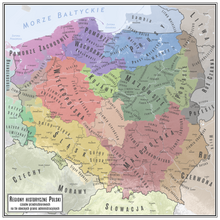Black Ruthenia
Black Ruthenia (Latin: Ruthenia Nigra), or Black Rus' (Belarusian: Чорная Русь, romanized: Čornaja Ruś; Lithuanian: Juodoji Rusia; Polish: Ruś Czarna), is a historical region on the Upper Neman, including Novogrudok, Grodno and Slonim.[1] Besides these, other important parts of Black Rus' are Vawkavysk and Białystok.[2] The region was inhabited by the Baltic Yotvingians from ancient times and the name "Black Russia" appeared relatively late.
On the 1712 map of French cartographer Henri Chatelain "Russie noire" (Black Ruthenia) is placed in region of Eastern Galicia (today Western Ukraine), which is traditionally known as "Russie rouge" (Red Ruthenia).[citation needed]
History
The convention of distinguishing different Ruthenian regions by colours was first done by Medieval Western and Central European historians from the 14th to 17th centuries.[1] It was first done circa 1360 by Heinrich von Mügeln, referring to the Black and Red Ruthenia (placing them in modern Ukraine).[citation needed] Some researchers claim that this color naming convention was influenced by the Mongol invaders, who used them for the cardinal directions.[3]
Sometimes in the 16th century, the names Black, White and Red Ruthenia were given respectively to the Grand Duchy of Moscow, the Grand Duchy of Lithuania, and Lithuanian-owned Ruthenian lands that were given to Poland during the Union of Lublin.[1]
According to Bancks' book from 1813, Black Russia was composed of the Governorates of Kaluga, Moscow, Tula, Ryazan, Vladimir and Yaroslav.[4]
According to Alfred Nicolas Rambaud in the late 19th century:
The Lithuanian territories of Grodno, Novogrodek and Belostok were sometimes called Black Russia.[5]

On some Polish maps "Black Ruthenia" (Rus Czarna) covered areas of modern Belarus, which were labeled "White Rutihenia" on other maps.
See also
References
- ^ a b c Spečiūnas, Vytautas. "Juodoji Rusia". Vle.lt (in Lithuanian). Archived from the original on 6 September 2021.
- ^ Sužiedėlis, Simas (1955). "Gudų dvejopa invazija". Tėvynės Sargas (in Lithuanian). 2. Brooklyn, New York, USA: 47.
- ^ Łatyszonek, Oleg (2006). Od Rusinów Białych do Białorusinów: u *zródeł białoruskiej idei narodowej [From White Ruthenians to Belarusians: at the sources of the Belarusian national idea]. Białystok: Uniwersytetu w Białymstoku. ISBN 9788374311205. OL 19715579M.
- ^ Bancks, John (1813). The Life of Peter the Great, Formerly Emperor of Russia. Moore & Lake. p. 7.
- ^ Rambaud, Alfred (1898). "2". History of Russia.
External links
 Media related to Black Ruthenia at Wikimedia Commons
Media related to Black Ruthenia at Wikimedia Commons
